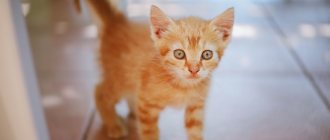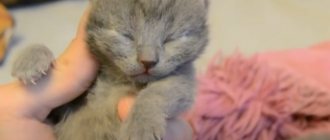Excellent eyesight for a cat is a real weapon that helps in hunting. Many cats, especially indoor ones, retain the ability to see well into old age. But at the same time, babies are born with tightly closed eyes and poor hearing. Very rarely, kittens can be born with their eyes already slightly open.
Over a short period, the eyes of newborn babies begin to open slightly and, as a result, open completely, allowing the kitten to gradually get used to the world around them. Many cat owners who have given birth to offspring worry about small lumps and one of the common questions is “When will the kittens open their eyes?”
How long can a cat give birth?
There are different stages of labor in both cats and dogs: precursors, uterine contractions, expulsion of the fetus and expulsion of the placenta. The average delivery time without complications is 20-25 hours. The duration depends on the number of kittens. A cat's first labor is usually longer.
Interesting materials:
How to use Hashtags in Stories? How to use Pva glue for decoupage? How to use furatsilin solution? How to use the Letual certificate online? How to use a Janome sewing machine? How to use sweet paprika? How to use a sling scarf? How to use a glass on the stock exchange? How are technical plants used? How to fix the clock on Samsung?
Why are kittens born blind?
It is clear that the little kittens that are born are not able to see, as they close their eyes tightly. Over time, they will develop the ability to look at the world around them, but it is not clear why nature intended for babies to be born hard of hearing.
Experts say that newborn kittens are not blind from birth, they are simply born with their eyes tightly closed - the eyelids are too closed. Even seeing a small squeaking cute lump in front of you, you need to understand that this is a real predator.
Most predators are born blind. This is due to the rapid progression of pregnancy in the female cat. Nature intended that the cat is not a pack animal; it finds its own prey, chasing it or running away from enemies. In the case of a longer pregnancy, the grown kittens would interfere with the female’s ability to obtain food for herself normally.
Babies born into the world do not have a fully formed body. After birth, kittens' hearing and vision continue to develop.
About problems and the need to call a veterinarian
Don't panic if the kittens' eyes haven't opened within two weeks. Wait another week and then start taking action.
If the kittens’ eyes have not opened 3 weeks after birth, then you need to contact a veterinarian
Fusion of eyelids
A long absence of eye opening in kittens may indicate fusion of the eyelids. If this problem occurs, the doctor will recommend a light massage. If it does not help, then a simple operation will be required, which is done under local anesthesia. An anesthetic is injected into the corners of the animals' eyes, after which a specialist cuts the eyelid with a sharp scalpel. At the end of the operation, the veterinarian recommends treating the eyes with a special solution (usually a 2% boric acid solution).
What to do if your eyes do not open on time
If a cub does not open its eyes for more than 2 weeks, this is not a cause for alarm. It is necessary to carefully examine the animal's eyelids. If there are no signs of inflammation, you can wash your eyes with a weak solution of boric acid or strong tea. You can take a moistened cotton pad and wipe your eyelids.
If they stick together, sour and crusts form, you must first soak them and then wipe them with light movements, avoiding pressure. If decay or inflammation is noticeable, you should immediately contact your veterinarian so that he can prescribe special drops.
1111
Contagious diseases
Damage to one eye is typical for the following infectious diseases:
- herpes;
- chlamydia;
- demodicosis;
Herpes
Blepharospasm
A viral disease better known as rhinotracheitis. An acute course is typical for unvaccinated kittens from two to three months. Chronic disease occurs in adult animals during periods of weakened immunity. At the initial stage, blepharitis develops, which is characterized by inflammation of the eyelids. They stick together and blepharospasm develops.
Subsequently, the second organ of vision is also affected. A characteristic sign of rhinotracheitis is ulcers on the cornea of the eye. Self-medication is dangerous because it can cause loss of one or both eyes, bronchopneumonia, constipation, and damage to internal organs. Treatment is prescribed by a veterinarian. To prevent sexual partners before mating.
Chlamydia
The bacterial infection primarily affects kittens from 1 to 3 months. At this time, death is possible. With chlamydia, one eye first becomes inflamed, then the second is affected.
Chlamydia affects one eye first
Treatment is prescribed by a veterinarian. If ophthalmic ointments or drops are used, two eyes should be treated, even though one of them looks healthy. Prevention consists of proper feeding, satisfactory living conditions and vaccination with a polyvalent drug against chlamydia and other dangerous diseases of cats.
Demodicosis
Demodectic glasses
The pathological process is caused by the activation of the subcutaneous mite due to weakening of the immune defense. With asymmetrical lesions, demodectic glasses are formed around one of the eyes. Soreness causes the pet to squint one eye.
Treatment consists of treating the affected surface with external insecticidal and acaricidal agents. If the pathological process goes far, inflammation occurs.
As the affected area heals, it scars and squinting becomes a lifelong cosmetic defect. Prevention consists of proper feeding, as well as applying insecto-acaricidal drops Spot on to the healthy, intact skin of the withers, which protect the pet from fleas, helminths, cutaneous and subcutaneous ticks.
Causes of blindness
Veterinary statistics note: in 90-95% of cases, vision loss in cats is acquired. The main risk factors leading to blindness:
- injuries that damage the tissues of the orbit;
- ophthalmic tumors;
- defects in the development of the optical system of the eye, the most dangerous of which are glaucoma (occurs due to excessive intraocular pressure) and cataracts (manifested by clouding of the natural lens - the lens due to impaired metabolism, infectious diseases, uncontrolled use of drugs);
- retinal detachment, often caused by heredity;
- inflammation of the cornea (keratitis), blood vessels (uveitis), nerves (neuritis);
- damage to the organs of vision by chlamydia - the simplest microorganisms of urogenital nature;
- pathologies and brain injuries that can lead to disruption of connections between the central nervous system and eye receptors;
- diabetes mellitus, leading to many degenerative consequences, including low vision or complete loss of visual function;
- vitamin deficiency, often observed in weakened, malnourished individuals;
- old age, at which many cats with a low level of immunity become blind.
In some pathological conditions - strokes, injuries - blindness can occur at lightning speed. With others - diabetic cataracts, glaucoma, retinal atrophy, ocular neuritis - visual acuity is gradually lost. In the latter case, the animal has time to get used to and adapt to low vision and blindness. Other sense organs come to the aid of the eyes - ears, nose, whiskers.
First aid at home
If you find purulent discharge in a cat and for some reason cannot immediately contact a veterinarian, then help the pet yourself, using available means. For example, plain warm water may be suitable for removing pus. She needs to moisten a soft cloth, gauze or towel. The wet part is placed on the pet’s closed eye and held in this position for about five minutes.
Afterwards, carefully wipe the eyes. This method will not replace full-fledged treatment, but it will remove the pus and partially relieve the pet from discomfort.
To remove pus, use only a soft, lint-free cloth.
Eye care
Newborn kittens have virtually no immunity, so their eyes, in particular, are at risk. Therefore, it is recommended to help the cat care for the babies. While the eyes remain closed, you can wipe them with a soft towel dipped in chamomile infusion or a light solution of furatsilin.
Attentive attitude, as well as knowledge of how long it takes for kittens to open their eyes and what can affect this, allows the owner to track pathologies at an early stage, and, if possible, eliminate the causes of the problems by consulting a doctor.
When kittens open their eyes
Veterinary experts say that the average time it takes for kittens to open their eyes is from 5 to 18 days. The process of opening the eyes is not abrupt, but gradual. At the initial stages, a small gap appears, allowing you to analyze the brightness of the light flux, then the pupil adapts.
After birth, the nervous system of cats is also not fully formed, so the speed of impulses along the nerve fibers is slightly inhibited, which causes immobility of the pupils in babies. The timing of eye opening in babies depends on several factors:
- Age of the mother cat. Young cats giving birth for the first time, as well as old animals, give birth to weakened offspring. Kittens born from a weak mother develop more slowly, open their eyes later, gain weight poorly and have a low immune status. Kittens born from a healthy cat open their eyes faster and grow stronger.
- Duration of the gestation period for kittens. The average gestation period for a cat is 60-62 days. Premature kittens born prematurely may be quite viable, but their development continues after birth, so these babies open their eyes much later.
- Gender. It has been proven that girls begin to open their eyes 1-2 days earlier than their brothers.
- Breed predisposition. Cats with long hair begin to open their eyes later than their relatives who have naturally short hair. Animals of hairless breeds may be born with their eyes already slightly open.
Owners of newborn kittens should know that all babies in the first days after opening their eyes have a gray-blue iris color. This period is characterized by the fact that animals see everything blurry, without the ability to clearly focus on an object. But they are able to distinguish between light and darkness and the size of an object.
The permanent eye color in cats is formed only by the 3rd month, but it is possible to accurately say the eye color of kittens only six months after their birth.
What breeds of cats do kittens open their eyes when?
Pedigree cats carry pregnancies differently, and their kittens, in turn, are born with their own characteristics. The timing of eye opening will depend on the breed. First on the list are Maine Coon cats. These big cats are also babies when they are. In adulthood, the weight of the animal reaches more than 10 kg. But children lag behind their peers in development, especially mongrel kittens. The body of a purebred kitten requires more time to develop and grow. For the first time, Maine Coon kittens open their eyes no earlier than 2 weeks after birth.
Bobtail kittens are also characterized by a long process of opening their eyes. Short-tailed babies begin to open their eyes 1.5-2 weeks after birth.
Hairless Sphynx cats, on the contrary, are characterized by rapid development, opening their eyes after birth on the 3-4th day, sometimes on 2. The eyes of Siamese kittens also open quickly.
Fluffy beauties - Scottish cats and Persians, lag behind their relatives in development, opening their eyes 10-12 days after birth. Vision formation occurs completely on days 8-10.
But the real record holders for the duration of eye opening are ragdoll kittens. The mother cat does not leave her offspring for at least 2 weeks. Babies begin to open their eyes 2.5 weeks after birth.
Features of breeds
The breed of cat also affects the time when kittens first open their eyes:
- In this series, the “foremost” are the sphinxes. Their cubs may already be born with open eyelids. As a rule, representatives of this breed begin to see clearly on the third day.
- Thai and Siamese babies gain sight between the third and sixth days of their stay in this world.
- In Siberian cats, the process begins 5-7 days after birth.
- During this period, Persians also become sighted.
- British babies are helpless until the 6th day of their life, and sometimes longer.
- Oriental cats also gain vision on the 6th day.
- The original record holders in this area are ragdolls, whose eyelids become unstuck no earlier than three weeks of age.
- Scottish “fluffies” begin to open their eyes on the fifth to eighth day, finally gaining sight only on the 14th day.
Interestingly, according to statistics, girls acquire vision earlier than boys, and representatives of long-haired breeds lag behind short-haired and hairless cats.
Also, often the eyes of the first kitten born open earlier than the others.
Signs of visual impairment
The owner can understand that the pet cannot see anything only when blindness occurs instantly. How can you check for gradual vision loss in a cat?
Veterinarians recommend paying attention to behavioral manifestations of developing pathology:
- preference for passive pastime (sleeping or just lying down) over active games;
- reluctance to hunt birds and mice;
- nervousness, fearfulness;
- unsure movement in a familiar room;
- long indecisiveness when exploring a new space, frequent bumping into objects;
- replacing former agility, agility, and agility with clumsiness and timidity;
- careful gait, no jumping;
- an absent-minded, cloudy gaze that cannot fixate on a moving object;
- attempts to examine objects with one eye (with one-sided blindness), for which the pet is forced to turn its head each time;
- broken mustaches who took on the role of the main coordinator in space.
When keeping a pet that is not accustomed to the street, it is not easy to notice deviations in behavior. The mustachioed pet manages to adapt well to its native walls, remembering the location of pieces of furniture and resting places. Only with cataracts will a cat's impending blindness be revealed by clouding of the pupil.











